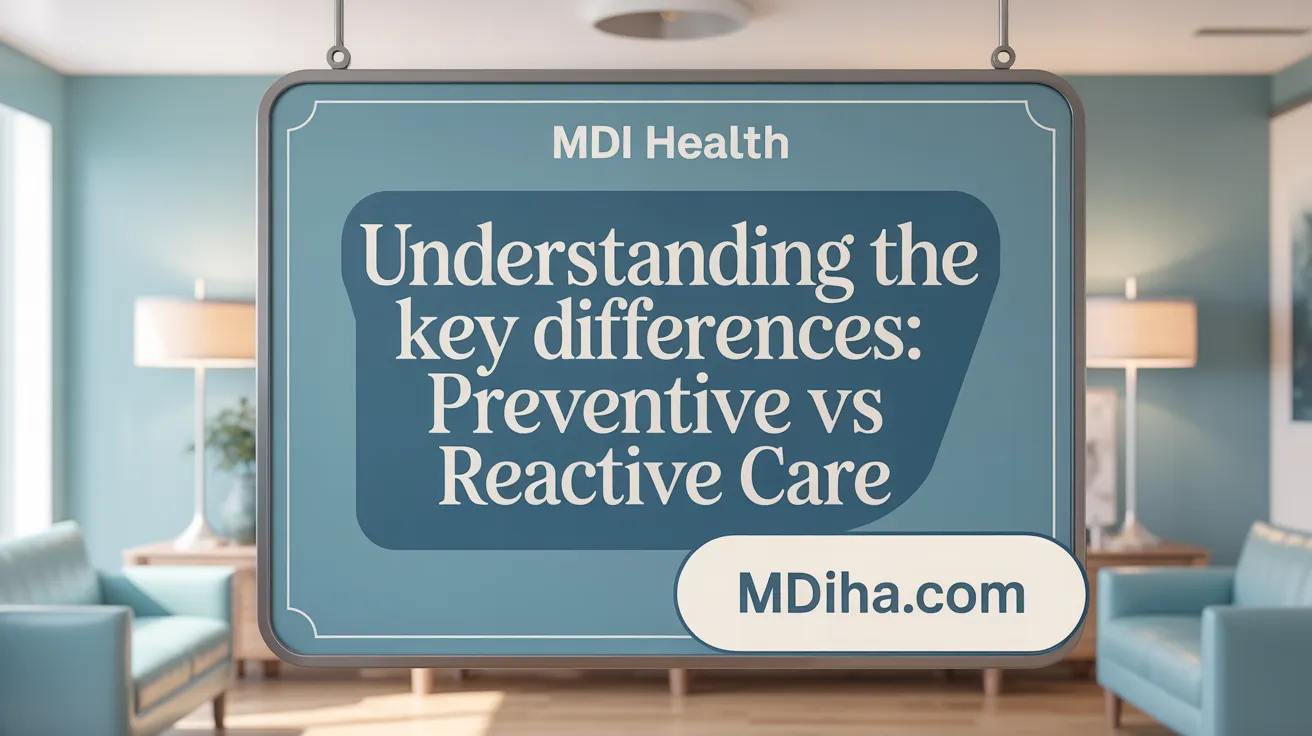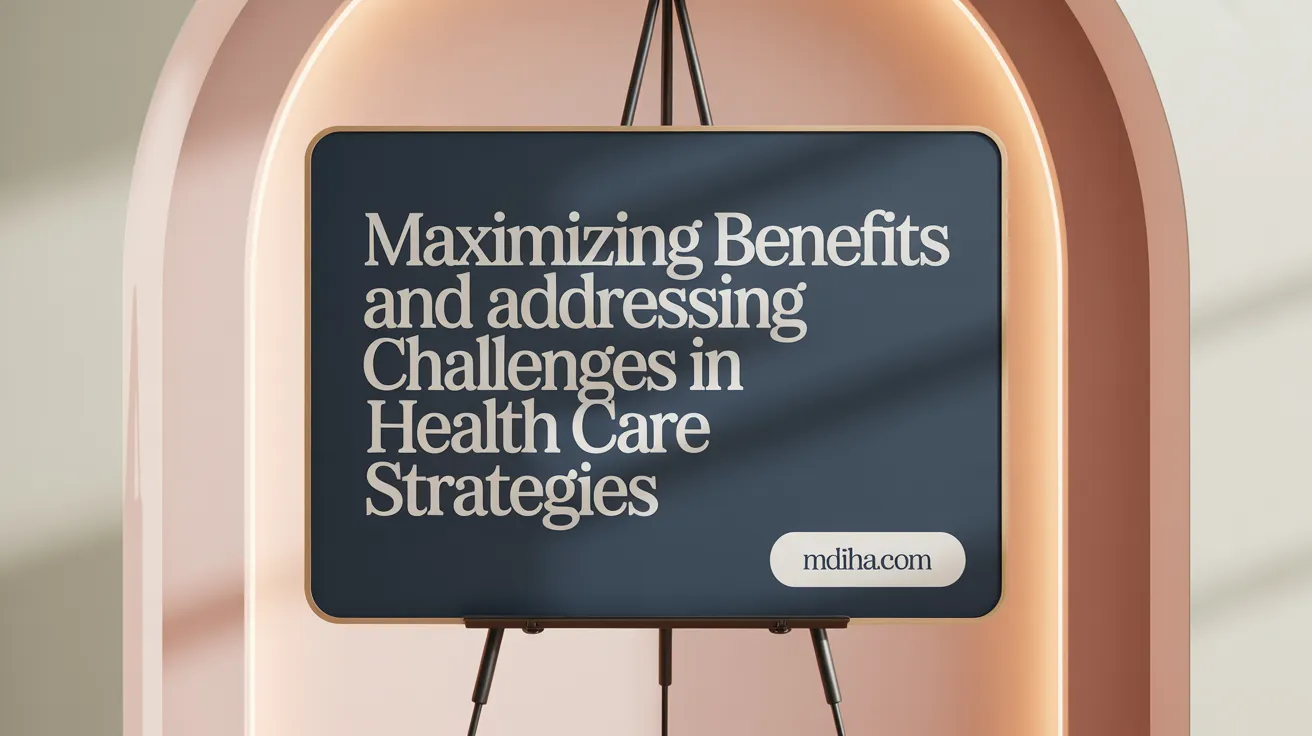Understanding Healthcare Approaches
Healthcare has traditionally been dominated by reactive care—treating illness after symptoms emerge. However, a transformative shift toward preventive and proactive strategies is reshaping the landscape, aiming to improve long-term health outcomes and system sustainability. This article explores the differences between preventive medicine and reactive care, their impact on health, costs, and how emerging technologies and policies are supporting this evolution toward proactive health management.
Defining Preventive Medicine and Reactive Care: Different Paths to Health Management

What are the key differences between preventive medicine and reactive care, including their definitions, principles, and approaches?
Preventive medicine emphasizes maintaining health and preventing disease before it occurs. It involves proactive interventions such as vaccinations, health screenings, lifestyle modifications, and cutting-edge molecular-based personalized approaches. The primary goal is to reduce the incidence of illnesses and mitigate their impact through early detection and health promotion.
In contrast, reactive care focuses on addressing health issues after symptoms appear or complications develop. This model provides immediate treatment for injuries, infections, or chronic conditions, often involving emergency interventions, medication, or surgical procedures. Reactive care aims to manage already-existing health problems rather than prevent them.
The core principles of preventive medicine include early detection through screenings, reducing risk factors, and promoting healthy behaviors. It relies on data and technology, including molecular insights, to identify vulnerabilities at a molecular level and tailor personalized interventions. Reactive care, meanwhile, is based on diagnosing and treating health issues as they manifest, often in response to urgent needs.
Over time, healthcare has shifted from an predominantly reactive model to an integrated system that incorporates both approaches. Advances in digital health tools like wearables, health data analytics, and molecular science support this transition by enabling earlier interventions and more precise, mechanism-based treatments.
Combining these strategies optimizes patient outcomes—preventing disease when possible, and effectively managing existing conditions—to reduce overall healthcare costs, improve quality of life, and promote lifelong wellness.
Impact of Preventive and Reactive Models on Long-Term Health Outcomes

How do preventive and reactive healthcare models impact long-term health outcomes?
Preventive healthcare models play a crucial role in shaping long-term health outcomes by emphasizing early detection, disease prevention, and tackling root causes of illnesses. Strategies such as vaccinations, healthy lifestyle modifications including diet and exercise, and routine screenings allow for identifying health issues before they escalate into serious conditions.
Thanks to advances in molecular biology , genomics, and regenerative medicine, modern preventive approaches are becoming more personalized and mechanism-based. These innovations enable targeted prevention at various stages, such as primordial prevention that addresses social determinants and primary prevention that prevents disease onset altogether.
Research consistently shows that preventive care leads to significant improvements in health longevity and quality of life. It reduces the incidence and severity of chronic diseases like heart disease, diabetes, and certain cancers, thereby lowering both individual and systemic health burdens.
On the other hand, reactive healthcare—focusing on treating health problems after symptoms appear—tends to result in poorer outcomes over time. It often involves high costs due to hospitalizations, advanced treatments, and managing complications that could have been mitigated with early intervention.
While reactive care remains essential for emergencies and acute conditions, its limitations include delayed diagnosis, higher treatment complexity, and increased economic burden. These factors contribute to worse long-term health outcomes and higher healthcare expenditures.
Evidence from scientific studies underpins these observations. For example, large-scale data demonstrate that populations engaged in preventive practices have lower rates of hospitalization, disability, and mortality. Real-world data from health systems show that preventive measures are cost-effective, alleviating pressures on healthcare resources and improving overall population health.
In summary, shifting the healthcare focus from reactive to proactive, through enhanced preventive strategies, promises better long-term health outcomes. It enhances quality of life, extends health span, and reduces the financial and societal costs associated with chronic illnesses, ultimately fostering healthier communities.
Benefits and Limitations of Preventive and Reactive Care

What are the benefits and limitations of preventive medicine in improving health, early disease detection, and reducing disease burden?
Preventive medicine plays a vital role in enhancing health outcomes and reducing the overall disease burden. Its advantages include significant reductions in the incidence of diseases such as heart disease, stroke, diabetes, and certain cancers by emphasizing lifestyle modifications, vaccinations, and screenings. Early detection allows for timely intervention, which can prevent the progression of chronic conditions and improve quality of life. Additionally, investing in prevention often results in substantial cost savings for healthcare systems, as it reduces the need for expensive treatments, hospitalizations, and long-term management of advanced diseases.
Despite its benefits, preventive medicine faces several challenges. Barriers such as limited access to healthcare services, lack of awareness about recommended screenings, and social determinants of health can hinder its efficacy. Moreover, over-screening or overtreatment may lead to unnecessary anxiety, invasive procedures, and increased healthcare costs without substantial benefit. Systemic focus on curative care rather than prevention also constrains the full potential of preventive strategies. Nonetheless, when effectively implemented, prevention is a cost-effective approach that significantly boosts long-term health and sustainability of healthcare resources.
What are the benefits and limitations of reactive care within health and social care systems?
Reactive care is essential for responding to acute health issues, injuries, and crises. Its primary benefit is providing immediate and personalized treatment for individual health problems, which is critical during emergencies or sudden illnesses. It ensures timely care, alleviating pain, managing injuries, and addressing urgent medical conditions.
However, reactive care has notable limitations. It often leads to higher healthcare costs because treating diseases at advanced stages is more complex and resource-intensive. It also tends to focus on managing symptoms rather than addressing underlying causes, which can result in recurrent health issues and poorer long-term prognosis. Over-reliance on reactive approaches can strain healthcare systems, cause hospital overcrowding, and result in avoidable complications.
With advances in molecular medicine and technology, combining reactive care with proactive and preventive measures can optimize outcomes. Early detection through screenings and personalized interventions can reduce the need for extensive reactive treatment later. An integrated approach that emphasizes prevention while maintaining reactive capacity ensures a balanced, efficient, and patient-centered healthcare system.
How can balancing both care types improve health outcomes?
Balancing preventive, proactive, and reactive care offers the most comprehensive strategy to improve health and optimize resource utilization. Prevention and early detection reduce disease incidence and severity, while reactive care addresses health emergencies effectively. Combining these components allows health systems to focus on maintaining wellness, preventing disease progression, and effectively managing health crises.
Such a balanced approach can lower healthcare costs by reducing hospital admissions, shortening treatment durations, and preventing complications. It also enhances patient satisfaction and quality of life by fostering early intervention and personalized care plans. Policymakers and healthcare providers working together to develop integrated care models and adopt innovative technologies will be critical in achieving an optimal mix of prevention and treatment. Ultimately, this comprehensive strategy ensures healthier populations and more sustainable healthcare systems.
Comparing Preventive, Reactive, and Proactive Healthcare Models
Preventive healthcare models are highly effective in reducing the incidence of diseases, promoting healthier populations, and lowering long-term healthcare costs. They focus on actions like vaccinations, screenings, and lifestyle modifications taken before health issues arise, which can prevent up to 80% of chronic conditions such as heart disease and diabetes. This early intervention helps identify health risks early, enabling timely management and reducing the need for costly treatments later.
Reactive healthcare, on the other hand, is primarily about treating health problems after symptoms appear. While essential for emergencies and managing acute illnesses, it tends to be less efficient for chronic disease control and incurs higher costs due to delayed treatment at more advanced disease stages. The reliance on reactive models often results in increased hospitalizations and long-term complications.
Proactive healthcare seamlessly combines prevention with early detection techniques, leveraging advancements in molecular biology, informatics, and personalized medicine. Technologies like wearable health monitoring devices, molecular-targeted therapies, and regenerative medicine allow healthcare systems to anticipate and address potential health issues well before they develop into serious conditions. This approach improves patient outcomes, enhances quality of life, and promotes sustainable health system use.
The integration of these models is supported by economic and health outcome data. Evidence indicates that proactive care can significantly reduce hospital readmissions and healthcare expenditures. For example, similarity in the effectiveness of proactive interventions correlates with lower hospitalization rates and better chronic disease management. However, challenges such as resource allocation, technology adoption, and disparities in access remain.
In summary, while each healthcare model has its role, the most effective health systems prioritize preventive and proactive strategies. These approaches not only improve individual health outcomes but also promote system sustainability by reducing reliance on reactive, high-cost treatments. Moving towards a health paradigm that emphasizes early intervention, technological innovation, and personalized care offers a pathway to a healthier, more efficient future.
The Role of Technology and Early Intervention in Enhancing Preventive Care

How do healthcare technologies, such as remote patient monitoring, support preventive care?
Healthcare technologies like remote patient monitoring (RPM) support preventive care by enabling continuous collection of health data outside traditional clinical settings. Wearable devices and telehealth platforms facilitate regular health assessments, vaccinations, and wellness visits, making preventive measures more accessible—particularly for individuals in remote or underserved communities. Advanced data sharing, coupled with artificial intelligence (AI) and predictive analytics, helps healthcare teams assess individual risks, personalize interventions, and anticipate potential health declines before symptoms manifest. This proactive approach promotes early management of health issues, reducing the likelihood of complications. Additionally, digital health tools streamline clinical workflows, decrease administrative burdens, and encourage patient engagement, all of which enhance adherence to preventive strategies and improve health outcomes. Overall, technology-driven solutions foster a shift from reactive to proactive healthcare, emphasizing prevention and early detection.
Why is early intervention, including screenings and health awareness, important in long-term health management?
Early intervention through screenings and health awareness is vital because it helps detect diseases at their earliest and most treatable stages. Regular screenings—for example, for cancer, diabetes, and cardiovascular conditions—allow for timely, personalized preventive strategies that can significantly improve long-term health outcomes. Promoting health literacy and awareness about social determinants of health encourages healthier behaviors, reduces risk factors, and supports the prevention of diseases before they develop or worsen. Implementing multilayered preventive measures—primordial, primary, secondary, tertiary, and quaternary—ensures comprehensive health management, minimizes the need for invasive treatments, and reduces long-term healthcare costs. Ultimately, early intervention not only extends lifespan and enhances quality of life but also alleviates the burden on public health systems and promotes sustainable health practices, making it a cornerstone of effective long-term health management.
Policy, Public Health, and Economic Implications of Preventive vs Reactive Healthcare
How do policy considerations and health plan coverage issues affect the provision of preventive services?
Policy considerations strongly influence the accessibility and scope of preventive healthcare. The Affordable Care Act (ACA) mandates that most health plans cover recommended preventive services at no out-of-pocket cost when delivered in-network. This policy removes financial barriers and encourages greater utilization of early detection measures like screenings and vaccinations.
Regulations specify that coverage should be based on recommendations from authoritative bodies, including the USPSTF, ACIP, and HRSA, which update their guidelines to reflect new evidence. However, some plans, such as grandfathered plans or certain employer-sponsored plans, may be exempt, limiting coverage access.
Legal and political debates also shape preventive coverage scope, with some exemptions granted for religious or moral reasons. These regulatory complexities affect what services are readily available and affordable, ultimately influencing early disease detection and prevention efforts.
What are the public health implications and strategies for integrating preventive measures into healthcare systems?
Integrating preventive strategies into healthcare systems enhances public health by reducing disease incidence and promoting health equity. Effective approaches include implementing a layered prevention framework—primordial through quaternary—to intervene early at various disease stages (Preventive healthcare practice and barriers).
Coordination across healthcare providers, public health agencies, and communities is vital. Strategies involve leveraging health information technology for data sharing, building community partnerships, and ensuring equitable access to screenings, immunizations, and health education.
Addressing barriers such as workforce capacity, lack of awareness, and resource limitations is essential. Policies should incentivize prevention through funding, training, and organizational change, creating a system that prioritizes upstream, population-based interventions (Clinical preventive services (CPS) importance and barriers).
In what ways do preventive strategies contribute to cost reduction and improve health system efficiency?
Prevention reduces long-term healthcare costs dramatically by cutting down on expensive treatments, hospital stays, and managing advanced chronic conditions (Shifting from reactive to proactive healthcare). Early detection through screenings and immunizations minimizes severe disease progression, leading to fewer emergency interventions (Benefits of preventive health and long-term savings).
Investing in social determinants and lifestyle modifications further lowers disease risks like heart disease and diabetes (Lifestyle modifications for heart disease). Community and public health programs targeting populations at risk are often more cost-effective than individual treatments.
Though initial investments in prevention can seem high, long-term savings are substantial. They include decreased hospital admissions, improved workforce productivity, and better resource allocation, ultimately leading to a more sustainable and effective health system (Proactive healthcare cost savings).
How do different healthcare approaches impact individual health and societal cost savings?
Preventive healthcare strategies significantly improve individual health by lowering disease risk, extending lifespan, and enhancing quality of life (Preventive care benefits and healthy aging). They reduce the need for invasive treatments and hospitalizations, leading to lower healthcare expenses.
Reactive care, while essential for treating acute illnesses, is associated with higher costs and poorer long-term outcomes because it often intervenes too late in disease progression (Reactive vs proactive healthcare models).
Societal implications are profound, as the heavy financial burden from managing chronic and complex conditions like cardiovascular disease and diabetes strains healthcare resources and inflates costs.
Investing in prevention shifts the focus from costly reactive treatment to proactive health maintenance, producing both health benefits for individuals and substantial economic savings for society (Preventive vs reactive healthcare: key to a healthier life).
Embracing a Balanced, Prevention-Focused Future
The transition from a predominantly reactive healthcare system toward one embracing preventive and proactive approaches marks a pivotal shift in promoting long-term health and sustainability. Preventive medicine's emphasis on early detection, lifestyle modifications, and advanced molecular strategies offers clear advantages in reducing disease burden and healthcare costs. While reactive care remains essential for acute and emergencies, integrating it with proactive monitoring and prevention delivers the most effective patient-centered outcomes. Technological innovations such as remote patient monitoring and predictive analytics bolster these proactive efforts, supporting personalized and timely interventions. Policy reforms and expanded coverage for preventive services under frameworks like the Affordable Care Act further facilitate access and equity. Ultimately, a healthcare paradigm that prioritizes prevention, integrates innovative technologies, and addresses social determinants will enhance population health, reduce costs, and build a resilient health system capable of meeting the challenges of the future.
